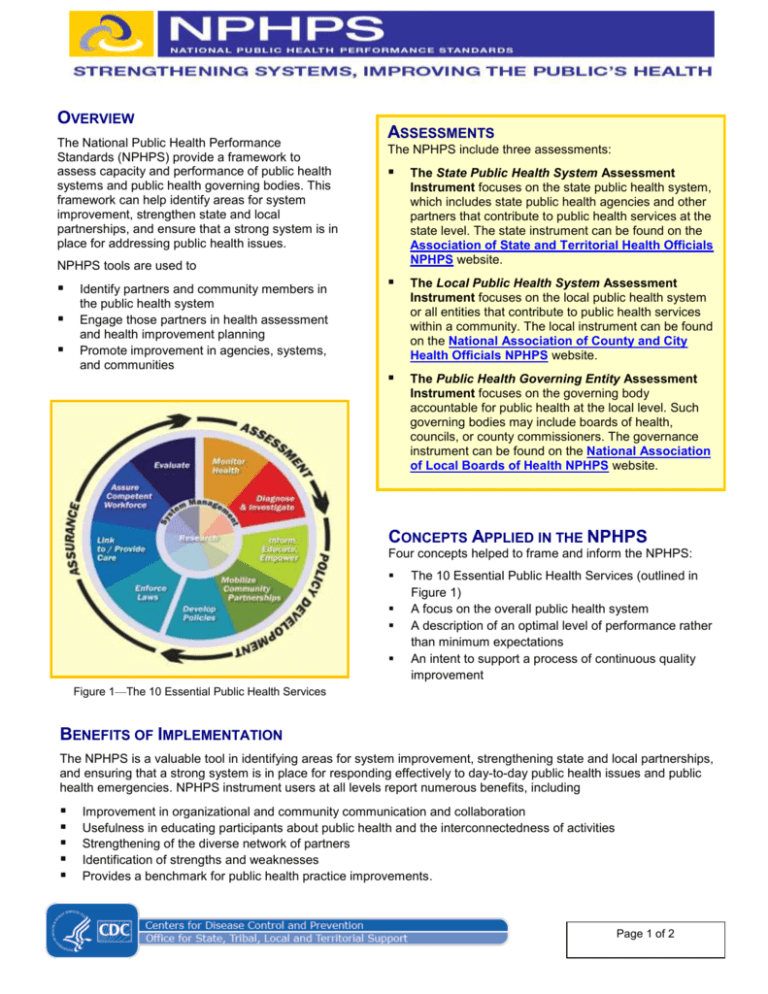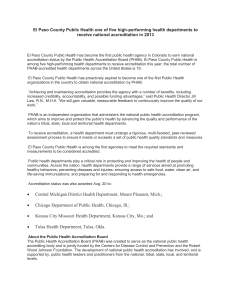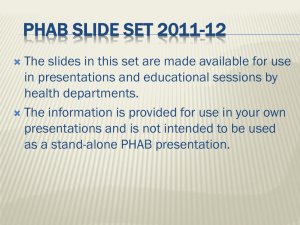NPHPS and Accreditation - The National Association of County and
advertisement

OVERVIEW The National Public Health Performance Standards (NPHPS) provide a framework to assess capacity and performance of public health systems and public health governing bodies. This framework can help identify areas for system improvement, strengthen state and local partnerships, and ensure that a strong system is in place for addressing public health issues. ASSESSMENTS The NPHPS include three assessments: The State Public Health System Assessment Instrument focuses on the state public health system, which includes state public health agencies and other partners that contribute to public health services at the state level. The state instrument can be found on the Association of State and Territorial Health Officials NPHPS website. The Local Public Health System Assessment Instrument focuses on the local public health system or all entities that contribute to public health services within a community. The local instrument can be found on the National Association of County and City Health Officials NPHPS website. The Public Health Governing Entity Assessment Instrument focuses on the governing body accountable for public health at the local level. Such governing bodies may include boards of health, councils, or county commissioners. The governance instrument can be found on the National Association of Local Boards of Health NPHPS website. NPHPS tools are used to Identify partners and community members in the public health system Engage those partners in health assessment and health improvement planning Promote improvement in agencies, systems, and communities CONCEPTS APPLIED IN THE NPHPS Four concepts helped to frame and inform the NPHPS: The 10 Essential Public Health Services (outlined in Figure 1) A focus on the overall public health system A description of an optimal level of performance rather than minimum expectations An intent to support a process of continuous quality improvement Figure 1—The 10 Essential Public Health Services BENEFITS OF IMPLEMENTATION The NPHPS is a valuable tool in identifying areas for system improvement, strengthening state and local partnerships, and ensuring that a strong system is in place for responding effectively to day-to-day public health issues and public health emergencies. NPHPS instrument users at all levels report numerous benefits, including Improvement in organizational and community communication and collaboration Usefulness in educating participants about public health and the interconnectedness of activities Strengthening of the diverse network of partners Identification of strengths and weaknesses Provides a benchmark for public health practice improvements. Page 1 of 2 NPHPS AND ACCREDITATION How does the NPHPS align with accreditation efforts? The NPHPS provides a framework for assessing public health system performance and thus helps health departments better understand their agency’s role in delivering essential public health services and interacting with public health system partners. This information may help state and local health departments prepare for or maintain accreditation status. There are three specific scenarios for which the NPHPS assessment process and results may help health departments with accreditation and quality improvement: 1. The Public Health Accreditation Board (PHAB) accreditation guidance specifically identifies NPHPS a tool or process that can be used meet PHAB standards 1.1.1 (state/community health assessment), 4.1.2 (models of community engagement), and 5.2.1 (community health improvement plan). 2. NPHPS can be used to identify and document the health department’s participation in, or contribution to, other public health system activities where collaboration is necessary to meet PHAB standards. Accreditation coordinators can use the NPHPS assessment process and its related documentation to identify partnerships necessary to meet PHAB standards. 3. Health departments can use NPHPS to identify potential quality improvement opportunities or solutions as part of meeting PHAB Standard 9.2. Results from the NPHPS strengths-weaknesses-opportunitiespriorities analysis can help health departments identify quality improvement projects, which can aid in the pre-accreditation stage. Health department staff can then use NPHPS post-assessment guidance to work through quality improvement planning and implementation. After accreditation, NPHPS assessment results can also give health departments ideas for addressing areas of weakness found during the accreditation process. DRIVING PERFORMANCE IMPROVEMENT STEPS TO THE PERFORMANCE IMPROVEMENT PROCESS 1. Organize participation for performance improvement. 2. Prioritize areas for action. 3. Explore root causes of performance. 4. Develop and implement improvement plans. 5. Regularly monitor and report progress. IMPLEMENTATION TIPS Use a systems approach—build on the collaboration begun during the assessment. Follow up with performance improvement priorities. Select key measures to monitor and manage. Link measurement to improvement. Always plan before taking action—take the time to set priorities and determine strategy. Align your strategies with your partner organizations. For more information, contact phpsp@cdc.gov or visit www.cdc.gov/nphpsp The NPHPS is a collaborative effort between CDC and the following partners: American Public Health Association • Association of State and Territorial Health Officials • National Association of County and City Health Officials • National Association of Local Boards of Health • National Network of Public Health Institutes • Public Health Foundation Page 2 of 2









